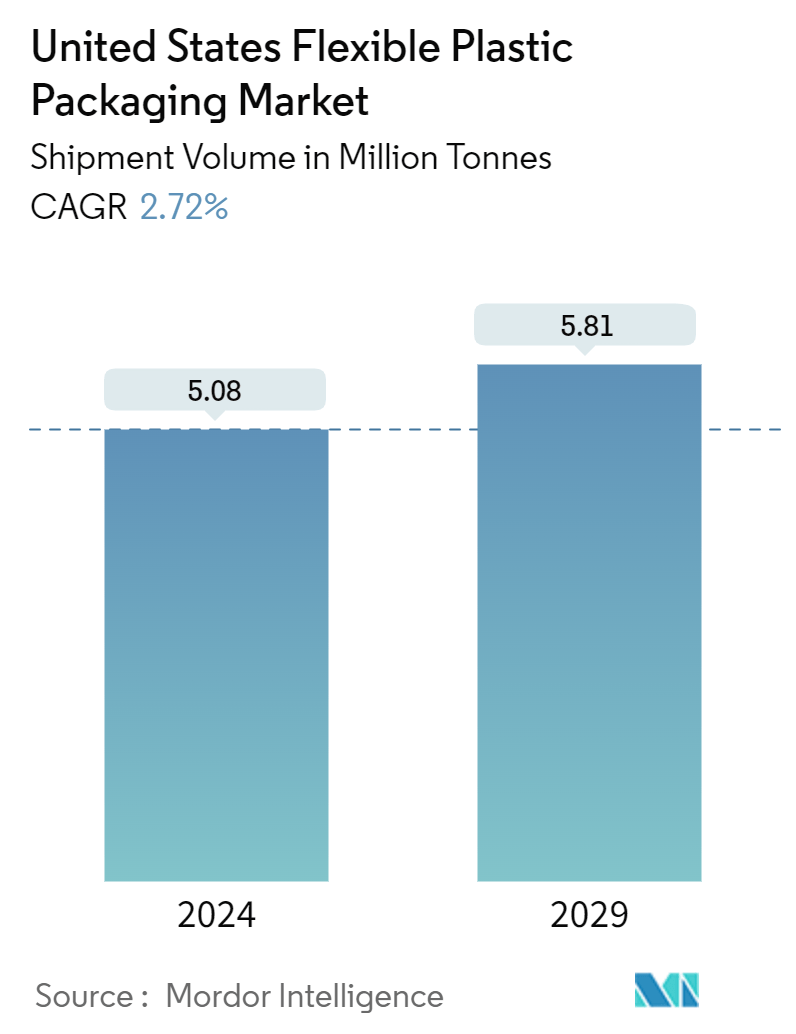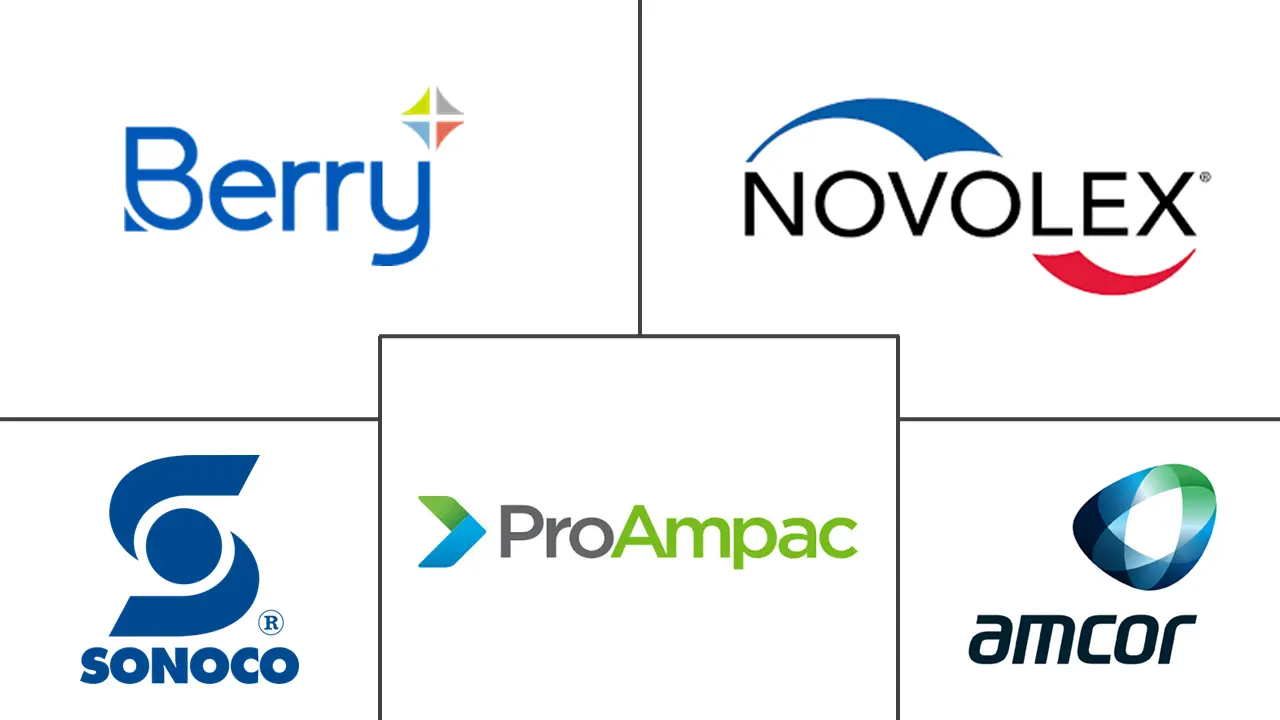Market Size of United States Flexible Plastic Packaging Industry

| Study Period | 2019 - 2029 |
| Base Year For Estimation | 2023 |
| Market Volume (2024) | 5.08 Million tonnes |
| Market Volume (2029) | 5.81 Million tonnes |
| CAGR (2024 - 2029) | 2.72 % |
| Market Concentration | Low |
Major Players
*Disclaimer: Major Players sorted in no particular order |
United States Flexible Plastic Packaging Market Analysis
The United States Flexible Plastic Packaging Market size in terms of shipment volume is expected to grow from 5.08 Million tonnes in 2024 to 5.81 Million tonnes by 2029, at a CAGR of 2.72% during the forecast period (2024-2029).
- Flexible plastic packaging allows more economical and customizable options for packaging products. It is particularly useful in industries requiring versatile packaging, such as the food and beverages, personal care, and pharmaceutical industries. It has grown popular due to its high efficiency and cost-effectiveness. Government agencies in the region fund projects to reduce carbon emissions and energy consumption, which can present a positive outlook in the market.
- The US Department of Energy (DOE) announced it would invest USD 13.4 million in funding to produce plastic with low energy consumption and minimum carbon dioxide emissions. This investment is focused on addressing metal waste recycling challenges. Since flexible packaging consumes less material than rigid packaging, it requires less production energy and helps reduce carbon emissions. Such initiatives will assist in promoting the development of bioplastic as a sustainable material for flexible plastic packaging and highlight flexible packaging as an economical substitute for rigid packaging.
- The need to integrate technology with packaging is driven by rising demand for packaging materials with improved barrier qualities, product innovation, and increasing supply chain digitization. The growth of the food ingredients market in the region is driven by the growth of the food and beverage industry, increasing consumption of dairy and frozen dairy products, and increased focus on demand for processed and packaged foods. Flexible plastic packaging is the common packaging material. The growing demand for portable and suitable food packaging is driving the use of flexible plastic packaging across various industries.
- Pouch packaging is rapidly gaining popularity as it is a highly convenient and portable solution. Many of today’s shoppers prefer flexible, stand-up pouches over traditional, rigid packaging. Consumers drove the demand for stand-up pouches (snacks, beverages, baby food, or industrial oils and lubricants) exponentially over the past decade. Specific innovations in the packaging type further drive the market's sustainability.
- For instance, in November 2023, ProAmpac, a US-based packaging and material science, introduced a sustainable alternative to traditional retort options called ProActive PCR retort pouches. These pouches are designed to reduce the use of new plastics and incorporate up to 30% post-consumer recycled material by weight. This aims to assist brands and retailers in achieving their circular economy objectives. The ProActive PCR retort pouches are specifically tailored for products like shelf-stable ready-to-eat proteins that require exceptional barrier properties and heat resistance.
- The market players are investing in new product development to satisfy customers' rising needs. For instance, in August 2023, TC Transcontinental Packaging, the Packaging segment of TC Transcontinental, announced an investment of USD 60 million toward developing advanced mono-material recyclable flexible plastic packaging solutions, providing high-performance polyethylene films with more heat resistance.
- The regional players are acquiring various packaging firms to expand their market presence. For instance, in February 2023, SEE announced that it completed the acquisition of Liquibox for a purchase price of USD 1.15 billion on a money and debt-free basis. This strategic investment unites two players in the flexible packaging industry and aligns with both companies' high-performance growth. Liquibox innovates and manufactures bag-in-box sustainable fluids and liquid packaging, dispensing products for fresh food, beverage, consumer goods, and industrial end-markets. This acquisition accelerates SEE’s fastest-growing segment, the CRYOVAC brand Fluids and Liquids business. CRYOVAC technology, scale, and market access provide significant synergies.
United States Flexible Plastic Packaging Industry Segmentation
The study on the US flexible plastic packaging market tracks demands in terms of revenue for flexible plastic packaging by material. It tracks the market size for respective end-user types. The US flexible plastic packaging market estimates include all the costs associated with flexible plastic packaging manufacturing, from raw material procurement to end-user industries. The estimates exclude the cost of the content that is or is to be packed inside the flexible plastic packaging. The scope of the flexible plastic packaging market is limited to B2B demand. Market numbers have been arrived at using bottom-up and top-down approaches for segmentation, and volume has also been considered.
The US flexible plastic packaging market is segmented by material (polyethylene [PE], bi-oriented polypropylene [BOPP], cast polypropylene [CPP], polyvinyl chloride [PVC], ethylene vinyl alcohol [EVOH], and other material types), product type (pouches, bags, films and wraps, and other product types), and end-user industry (food [baked food, snacked food, meat, poultry, and seafood, candy/confections, pet food, and other food], beverage, personal care and cosmetics, and other end-user industries). The report offers market forecasts and volume (tonnes) sizes for all the above segments.
| By Material Type | |
| Polyethene (PE) | |
| Bi-oriented Polypropylene (BOPP) | |
| Cast Polypropylene (CPP) | |
| Polyvinyl Chloride (PVC) | |
| Ethylene Vinyl Alcohol (EVOH) | |
| Other Material Types |
| By Product Type | |
| Pouches | |
| Bags | |
| Films and Wraps | |
| Other Product Types |
| By End-user Industry | ||||||||
| ||||||||
| Beverage | ||||||||
| Personal Care and Cosmetics | ||||||||
| Other End-user Industry (Pharmaceutical, Medical, Construction, Industrial Application, and Consumer Electronics Packaging Industries) |
| By Country | |
| United States | |
| Canada |
United States Flexible Plastic Packaging Market Size Summary
The United States flexible plastic packaging market is poised for significant growth, driven by its cost-effectiveness and versatility across various industries such as food and beverages, personal care, and pharmaceuticals. This packaging solution is increasingly favored for its ability to reduce material usage and energy consumption, aligning with governmental initiatives aimed at lowering carbon emissions. The market is witnessing a surge in demand for innovative packaging solutions, particularly pouches, which offer convenience and portability. The rise of technology integration in packaging, along with the growing food ingredients market, further propels the adoption of flexible plastic packaging. Companies are investing in sustainable alternatives and advanced materials to meet the evolving consumer preferences and regulatory standards, highlighting the market's shift towards eco-friendly solutions.
The market landscape is characterized by a fragmented structure with key players like Berry Global Group, ProAmpac LLC, and Amcor Group GmbH leading the charge in innovation and sustainability. These companies are actively developing products that incorporate recycled materials and meet circular economy objectives. The demand for flexible packaging is bolstered by the increasing consumer preference for convenience, particularly in the food and beverage sector, where ready-to-eat and portable options are gaining traction. The expansion of recycling facilities and the introduction of new technologies underscore the industry's commitment to sustainability and meeting the growing demand for recyclable and compostable packaging solutions. As the market continues to evolve, the focus remains on providing high-performance, environmentally friendly packaging options that cater to diverse consumer needs.
United States Flexible Plastic Packaging Market Size - Table of Contents
-
1. MARKET INSIGHTS
-
1.1 Market Overview
-
1.2 Industry Attractiveness - Porter's Five Forces Analysis
-
1.2.1 Bargaining Power of Suppliers
-
1.2.2 Bargaining Power of Buyers
-
1.2.3 Threat of New Entrants
-
1.2.4 Threat of Substitutes
-
1.2.5 Intensity of Competitive Rivalry
-
-
1.3 Industry Value Chain Analysis
-
-
2. MARKET SEGMENTATION
-
2.1 By Material Type
-
2.1.1 Polyethene (PE)
-
2.1.2 Bi-oriented Polypropylene (BOPP)
-
2.1.3 Cast Polypropylene (CPP)
-
2.1.4 Polyvinyl Chloride (PVC)
-
2.1.5 Ethylene Vinyl Alcohol (EVOH)
-
2.1.6 Other Material Types
-
-
2.2 By Product Type
-
2.2.1 Pouches
-
2.2.2 Bags
-
2.2.3 Films and Wraps
-
2.2.4 Other Product Types
-
-
2.3 By End-user Industry
-
2.3.1 Food
-
2.3.1.1 Baked Food
-
2.3.1.2 Snacked Food
-
2.3.1.3 Meat, Poultry, and Sea Food
-
2.3.1.4 Candy/Confections
-
2.3.1.5 Pet Food
-
2.3.1.6 Other Food (Dairy Products, Frozen Food, and Fresh Produces such as Fruits and Vegetables, etc.)
-
-
2.3.2 Beverage
-
2.3.3 Personal Care and Cosmetics
-
2.3.4 Other End-user Industry (Pharmaceutical, Medical, Construction, Industrial Application, and Consumer Electronics Packaging Industries)
-
-
2.4 By Country
-
2.4.1 United States
-
2.4.2 Canada
-
-
United States Flexible Plastic Packaging Market Size FAQs
How big is the United States Flexible Plastic Packaging Market?
The United States Flexible Plastic Packaging Market size is expected to reach 5.08 million tonnes in 2024 and grow at a CAGR of 2.72% to reach 5.81 million tonnes by 2029.
What is the current United States Flexible Plastic Packaging Market size?
In 2024, the United States Flexible Plastic Packaging Market size is expected to reach 5.08 million tonnes.

